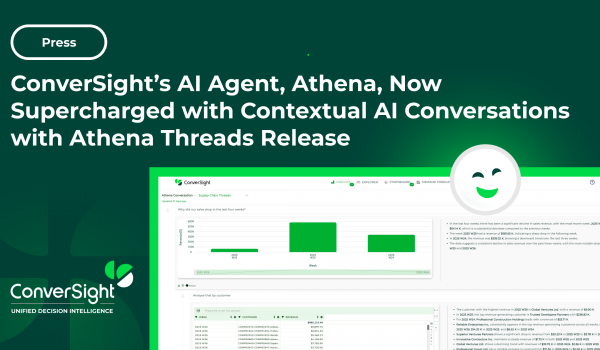Introduction
In a business world defined by rapid shifts in technology, market dynamics, and customer expectations, efficiency alone is no longer enough. Enterprises today need systems that not only support daily operations but actively drive growth, adaptability, and data-driven decision-making. That’s where the best ERP Systems step in – unifying finance, inventory, HR and more.
At its core, an ERP system is a unified platform that connects finance, inventory, human resources, customer management, supply chain, and beyond—offering organizations a single source of truth. In 2025, the role of ERP has expanded beyond just automation. It now forms the digital backbone of modern enterprises, enabling real-time insights, seamless collaboration, and the agility to scale operations as the market evolves.
But with a crowded ERP landscape and growing pressure to do more with less, selecting the right system can make or break an organization’s digital future. The stakes are higher than ever—especially for growing small businesses looking to build operational maturity, mid-market companies seeking smarter resource planning, and large enterprises aiming to modernize legacy systems. Crowded ERP landscape and growing pressure to do more with less, selecting the right system can make or break an organization’s digital future.
This guide compares the best ERP Systems across industries to help CIOs, CTOs, CFOs, supply chain leaders, demand planners, supplier planners, and IT leaders navigate this complex decision. Whether you’re in manufacturing, distribution, retail, or services, this comprehensive breakdown will walk you through the features, vendors, and evaluation criteria that define the best ERP systems in 2025—and how to choose one that fits both your business model and your growth goals.
What Makes an ERP System “The Best”?
When evaluating ERP systems in 2025, it’s important to look beyond brand recognition. A top-performing ERP system must align with your business goals, scale with your operations, and deliver decision-ready insights. Here’s what to look for:
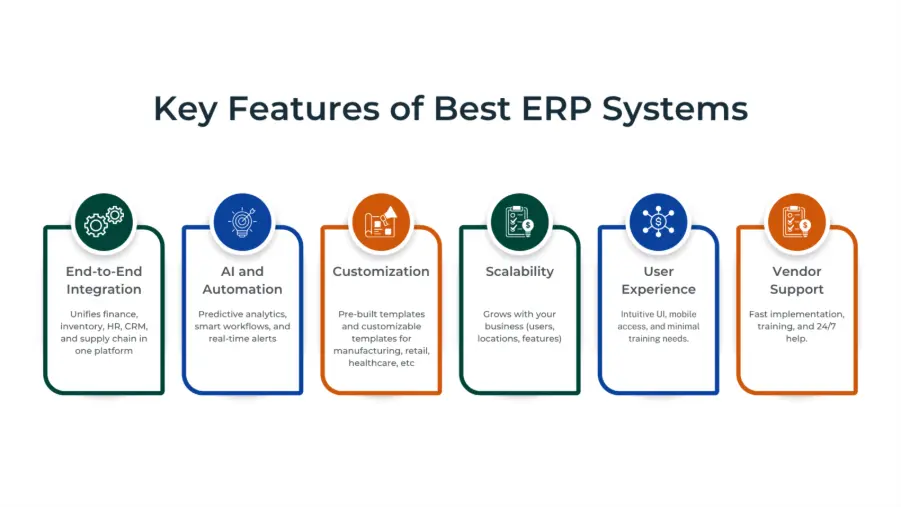
ERP Vendors: Top Platforms in 2025
With hundreds of platforms available, the best ERP systems in 2025 fall into two categories: enterprise powerhouses and cloud-first innovators. Here’s a vendor breakdown, emphasizing business value and ideal fit:
SAP
Designed for enterprises with global scale and stringent process control. Its S/4HANA suite delivers deep capabilities across finance, procurement, and manufacturing. Ideal for large manufacturers and retailers needing granular control, strong compliance tracking, and real‑time analytics for decision-makers.
Oracle NetSuite
A modular, cloud-native ERP built for fast-scaling organizations. With strong multi-entity accounting, unified CRM, and real-time dashboards, it enables visibility across subsidiaries. Best for finance-led mid-market firms, eCommerce players, and multi-location businesses that need fast deployment and consolidation.
Microsoft Dynamics 365
Seamlessly integrates with Microsoft 365, Azure, and Power Platform. Ideal for teams already embedded in the Microsoft ecosystem, it offers unified workflows across finance, sales, and operations. Great for service firms, field-service organizations, and professional services that value productivity tools and automation.
Sage X3
Designed for mid-market manufacturers and distributors needing industrial-strength operations management. Its vertical-specific functionality supports complex production environments with shop floor control, batch processing, and global compliance. Ideal for process manufacturers (food & beverage, chemicals) and discrete manufacturers with multi-site operations that require granular traceability and real-time production monitoring.
Sage Intacct
A cloud-native financial management system built for growing service businesses and financial teams. Delivers automated revenue recognition, multi-entity consolidation, and AI-driven financial reporting. Best for professional services, SaaS companies, and nonprofits that need real-time visibility into financial performance without complex IT infrastructure.
Acumatica
Cloud-native with a usage-based pricing model. Its open architecture makes it highly customizable and easy to tailor for industry-specific workflows. Well-suited for SMBs in manufacturing, distribution, and construction looking for flexibility without heavy overhead.
Priority ERP
A flexible, low-code platform with strong manufacturing and field-service modules. Stands out for rapid customization and vertical-specific templates (e.g., food & beverage, automotive). Best for mid-market companies needing industry-fit without complex coding.
Fishbowl Inventory
Specialized inventory and warehouse management for SMBs. Integrates with QuickBooks and offers advanced features like barcode scanning and manufacturing work orders. Ideal for growing distributors and light manufacturers needing inventory-centric ERP at an affordable price.
Odoo
An open-source, modular platform that lets you build the exact feature set you need—starting small and scaling gradually. Perfect for startups and budget-conscious teams who want affordability, fast deployment, and the ability to customize.
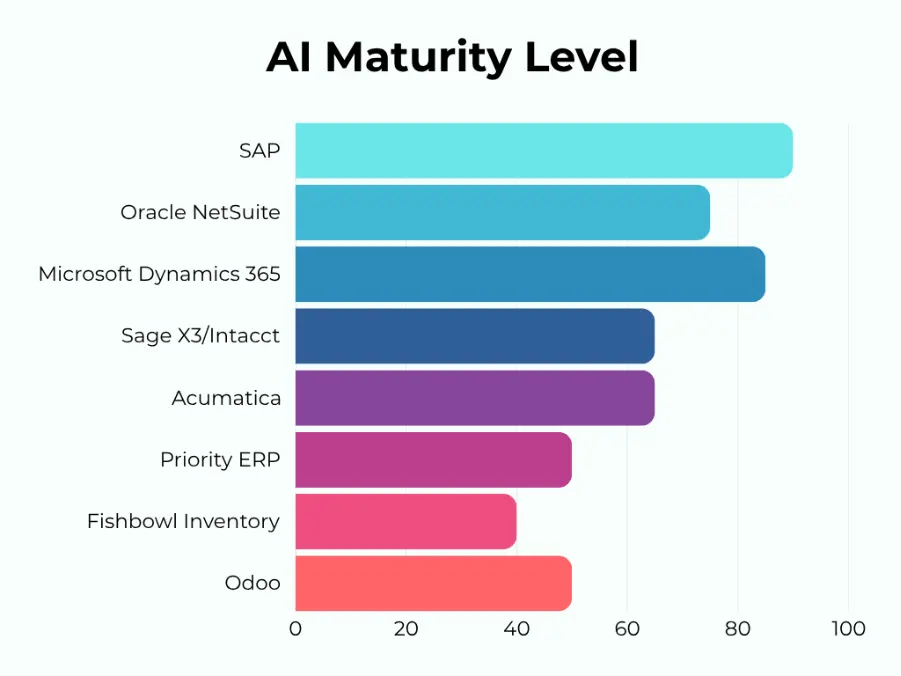
ERP Is Evolving: Why AI-Driven Systems Are Now
The best ERP systems of 2025 are evolving with AI, transforming from data tools to decision engines. This transformation is being fuelled by Artificial Intelligence, which is reshaping how ERP platforms operate, deliver value, and drive action across the business.
No longer confined to historical reporting or basic automation, modern ERP systems now leverage AI to anticipate needs, automate complex workflows, and surface insights that were previously buried in spreadsheets or siloed systems. Here’s how AI is defining the next generation of ERP:
Predictive Analytics
AI-powered ERP platforms can now forecast demand, cash flow, supply delays, and staffing needs based on real-time and historical data. Instead of static reports, businesses get dynamic insights — helping leaders proactively address risks, optimize resources, and respond faster to market changes. For example, a manufacturer using an AI-driven ERP might detect upcoming shortages based on production trends and supplier delays, then automatically suggest reordering plans to maintain operational continuity.
Workflow Automation
AI also simplifies daily operations by automating decision-heavy processes like purchase approvals, invoice matching, and resource allocation. Rather than relying on fixed rule-based automation, modern ERP systems now use machine learning to recognize patterns in how tasks are handled and optimize them over time. This results in smarter, faster workflows that adapt to changing business behavior and reduce manual effort. For example, if the system learns that a particular vendor always delivers late, it can recommend alternatives or trigger reorder alerts sooner—without human intervention.
Intelligent Dashboards
ERP dashboards have evolved beyond static graphs. With AI, they now highlight what matters most through alerts, trend visualizations, and prescriptive recommendations. Users no longer need to dig through layers of reports. Instead, intelligent dashboards deliver real-time clarity — tailored by role and function — so that stakeholders can act with confidence and speed.
How ConverSight Adds Decision Intelligence on Top of Any ERP
Most ERP platforms are built for structured data entry and process management. But even the most robust ERPs still expect users to dig through dashboards or know the right filters to apply. Business users are often left waiting on analysts or toggling between modules to find answers. ConverSight changes that dynamic entirely.
Unlock Instant Answers with Conversational Intelligence
ConverSight overlays your ERP with a conversational AI layer that makes information searchable using natural language. Whether it’s SAP, Oracle NetSuite, Microsoft Dynamics 365, Acumatica, Odoo, Epicor, Infor, Sage, QuickBooks, or any other industry-specific ERP—ConverSight integrates with minimal IT effort.
Ask: “What are last quarter’s sales by region?”
Get: Real-time, visual insights in seconds—no manual reporting required.
This removes the friction between data and decision-making, allowing users across departments to query their ERP like they would a colleague.
Predictive, Proactive, and Personalized Intelligence
ConverSight goes beyond surface-level reporting with a full suite of decision intelligence capabilities that turn ERP data into real business value:
- AI-Powered Analytics: Drill deep into sales, inventory, finance, and operations with contextual dashboards tailored to each role.
- Predictive Forecasting: Anticipate demand shifts, budget trends, or supply chain bottlenecks with models trained on historical ERP data.
- Smart Alerts: Stay ahead of issues with automated notifications on threshold breaches, anomalies, or underperformance.
- Storyboards & Narratives: Build shareable, executive-ready reports that auto-update with the latest ERP data—perfect for cross-functional syncs or leadership reviews.
Example: Get notified when margins fall below 10% in a product line or when purchase orders delay delivery beyond lead time expectations.
One Platform, Unlimited Visibility
Every department—from finance and operations to sales and supply chain—gains role-specific visibility without needing multiple tools or manual exports. Dashboards adapt to what each user needs:
- CFOs track cash flow, margins, and budget variance.
- Operations teams monitor inventory turnover and demand gaps.
- Sales leaders view pipeline progression and regional performance.
- Procurement keeps tabs on supplier lead times and PO accuracy.
All of this happens in real time, powered by your existing ERP infrastructure and enhanced with ConverSight unified decision intelligence platform.
Effortless ERP Integration, Maximum ROI
ConverSight connects to your ERP using plug-and-play APIs, avoiding complex reconfiguration or disruption. Data syncs securely and continuously, ensuring every insight is based on the most recent information. Whether you’re on a legacy system or a modern cloud ERP, integration is swift, scalable, and IT-light.
Improving ERP Decision-Making with ConverSight
Traditional ERP systems do a great job of capturing data—but they often fall short when it comes to enabling fast, informed decisions. Reports take time, insights are hard to access, and users are often dependent on analysts or IT teams for answers. This creates delays and disconnects between data and action.
ConverSight bridges that gap by adding a layer of decision intelligence on top of any ERP system—transforming how teams interact with data and make decisions.
Here’s how ConverSight enhances ERP systems:
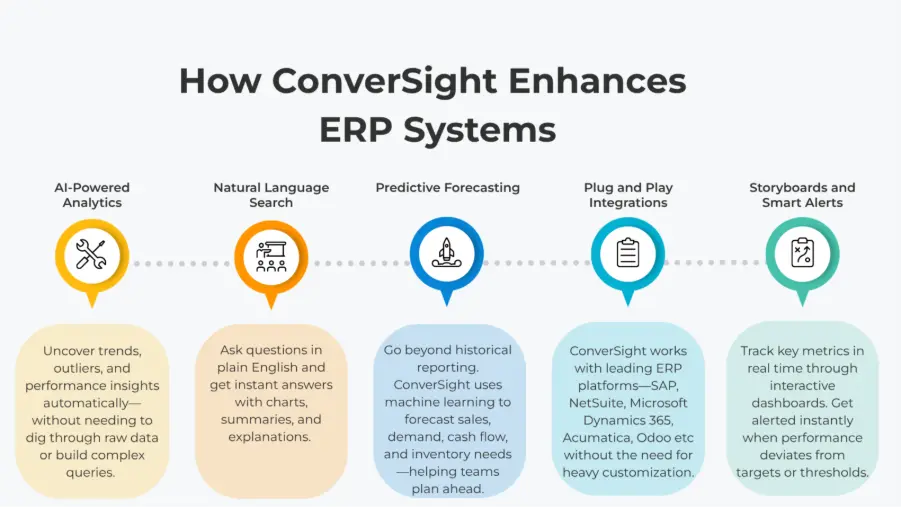
Together, these capabilities help organizations move from static reporting to real-time, AI-assisted decision-making—directly within the ERP environment.
CTA: Download the ERP Intelligence Whitepaper
Which ERP Works Best for Your Business Type
Each industry brings unique processes, compliance needs, and operational challenges — from managing complex supply chains in manufacturing to omnichannel operations in retail. Choosing an ERP that fits your business model ensures long-term scalability, operational control, and faster ROI.
ERP for Small Business
Overview: Small businesses need ERP systems that simplify operations without complex IT requirements. The ideal solution offers quick implementation, affordable pricing, and core functionality to support growth.
Key Priorities:
- Affordable total cost of ownership
- Easy-to-use interface with minimal training
- Core financials and inventory management
- Scalability for future expansion
ERP Capabilities to Look For:
- Cloud-based deployment options
- Integrated CRM and eCommerce features
- Mobile access for remote teams
- Pre-built templates for quick setup
ERP System for Manufacturing
Overview: Manufacturers depend on ERP systems to align supply with demand, optimize production schedules, and maintain traceability. Complex operations like shop floor control, raw material planning, and BOM (Bill of Materials) tracking demand precision.
Key Priorities:
- End-to-end production planning and execution
- MRP (Material Requirements Planning)
- BOM management and work orders
- Quality control and regulatory compliance
ERP Capabilities to Look For:
- Real-time inventory and production monitoring
- Integration with MES and supply chain platforms
- Multi-plant and multi-currency support
- Automated quality checks and compliance reports
ERP for Wholesale & Distribution
Overview: Distributors manage large volumes of inventory across multiple warehouses with tight delivery timelines. Their ERP needs to streamline fulfilment, optimize stock levels, and provide clear visibility across the supply chain.
Key Priorities:
- Centralized inventory control across locations
- Real-time order and shipment tracking
- Vendor and pricing management
- Returns and replenishment workflows
ERP Capabilities to Look For:
- Advanced warehouse and logistics modules
- Multi-location inventory forecasting
- Real-time shipping and fulfilment integration
- Barcode scanning and mobile warehouse apps
ERP for Retail & eCommerce
Overview: Retailers and online sellers must manage inventory, pricing, and customer data across channels. From storefront to backend, the ERP must provide centralized visibility and seamless integration with eCommerce platforms and POS systems.
Key Priorities:
- Real-time inventory sync across channels
- Dynamic pricing and discount management
- Returns, refunds, and loyalty tracking
- Customer and product analytics
ERP Capabilities to Look For:
- eCommerce and POS integrations (e.g., Shopify, Magento)
- Centralized product and pricing catalogs
- Omnichannel order management and fulfilment
- Customizable dashboards and KPIs
ERP for Service-Based Industries
Overview: For service firms — consulting, IT, agencies — people are the product. ERP systems must track time, projects, expenses, and billings while offering strong analytics on profitability and utilization.
Key Priorities:
- Time and expense tracking
- Project budgeting and delivery oversight
- Resource planning and allocation
- Recurring and milestone-based billing
ERP Capabilities to Look For:
- Project accounting and timesheet automation
- Real-time margin and utilization tracking
- Integration with CRM and PSA tools
- Client reporting and revenue recognition
Cloud ERP Systems
Overview: Cloud-based ERP solutions provide flexibility, scalability, and reduced IT overhead. These systems are ideal for businesses wanting automatic updates, remote access, and AI-driven capabilities.
Key Priorities:
- Subscription-based pricing models
- Automatic software updates
- Disaster recovery and data security
- Mobile and remote workforce support
ERP Capabilities to Look For:
- Native AI and analytics features
- API-first architecture for integrations
- Global accessibility with low latency
- Usage-based scaling options
ERP System Integration
Overview: Modern ERP systems must seamlessly connect with existing business applications to create a unified data ecosystem and eliminate silos.
Key Priorities:
- Pre-built connectors for common business apps
- Open API architecture
- Real-time data synchronization
- Unified reporting across systems
ERP Capabilities to Look For:
- Native integrations with CRM and eCommerce platforms
- Middleware compatibility
- BI and analytics tool connectivity
- IoT and edge device integration
How to Choose the Best ERP System for Your Team
Don’t Just Pick Features— Find the Right Fit for Your Business Goals
Choosing the best ERP system goes beyond feature checklists. In 2025, successful businesses are selecting ERP platforms that align with their long-term digital strategy, data maturity, and operational flexibility. The right system should support your workflows, scale with your business, and deliver real-time insights that drive confident decision-making across teams.
Modern ERP evaluation requires a balance of functionality, flexibility, and long-term visibility. Whether you’re a fast-growing SMB or a mature enterprise, consider how the ERP fits your existing tech stack, how easily it integrates with tools like ConverSight, and whether it empowers your team—not burdens them.
Key Factors to Evaluate:
Ease of Use for Business Teams: Look for intuitive interfaces, customizable dashboards, and minimal learning curves. Your ERP should enable adoption across departments—not require constant IT support.
Modular & Scalable Architecture: Choose an ERP that allows you to activate features as your business grows—whether you’re expanding to new markets, product lines, or subsidiaries.
AI & Analytics Capabilities: Modern ERPs must go beyond transactions. Built-in analytics, forecasting, and automation can turn data into proactive decisions across operations, finance, and supply chain.
Integration Flexibility: Ensure your ERP can connect seamlessly with existing tools—CRMs, eCommerce platforms, WMS, or BI tools. Open APIs and pre-built connectors are a must.
Industry Fit & Best Practices: Prioritize solutions built with your sector in mind—whether you’re in manufacturing, distribution, retail, or services. Pre-configured modules and templates can drastically shorten time to value.
Implementation Speed & Vendor Support: Partner with vendors that offer agile deployment models, clear timelines, and robust post-launch support. Fast implementation with minimal disruption is crucial for ROI.
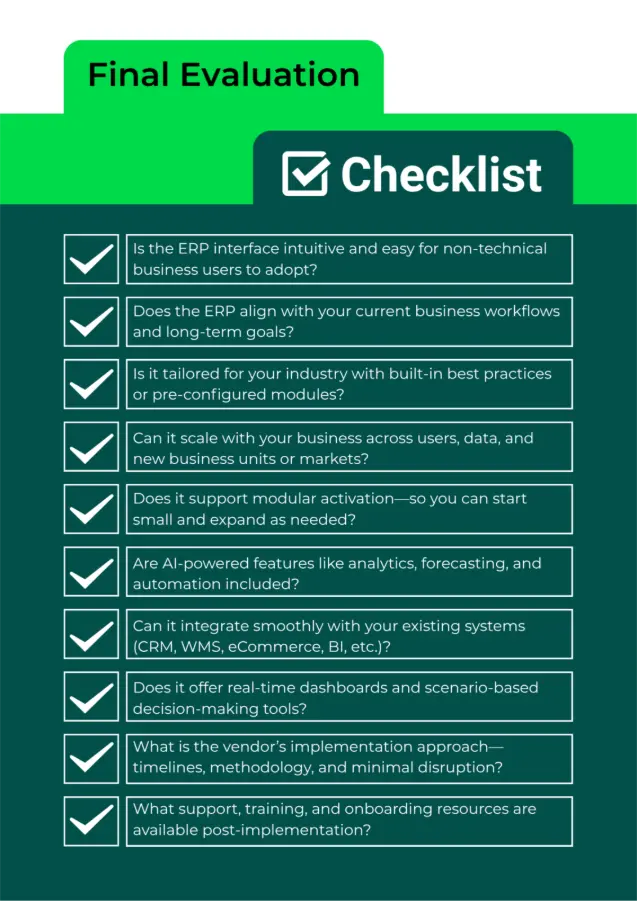
Conclusion
As business leaders in 2025 face increasing pressure to adapt faster, operate leaner, and make decisions with greater confidence, selecting among the best ERP systems is foundational to your success. It’s not just about managing finance, inventory, or HR—it’s about creating a connected, intelligent backbone for your organization.
The right ERP brings visibility across departments, streamlines operations, and empowers your teams to act with clarity. But even the most robust ERP can leave decision-makers waiting—digging through dashboards or relying on siloed reports.
That’s where ConverSight transforms your ERP from a system of record into a system of insight. By layering AI-powered decision intelligence on top of your existing ERP, ConverSight helps business users get instant answers, uncover hidden trends, and make proactive decisions—all in plain language.
Integrating your ERP with ConverSight bridges the gap between data and action—turning your ERP into a smarter, faster, and more responsive platform for business growth.


